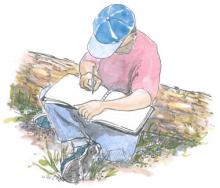A Overview of Connections of Ricky’s Atlas: Mapping a Land on Fire to the Next Generation Science Standards
Ricky’s Atlas is a story of two almost-sixth graders exploring the dry forests and grasslands in the rain shadow of Oregon’s Cascade Mountains. The combination of story and research-based science provides many opportunities for interdisciplinary reading, writing and science activities. Broad discussions about overall themes of the book, roles of the main characters, and development of the “atlas” drawn by Ricky would make good connections between science and literary objectives. In this guide for teachers I suggest ways in which information in Ricky’s Atlas, sometimes with materials accessible online, can be used to meet Next Generation Science Standards (NGSS). These include disciplinary core, science and engineering practices, and cross-cutting concepts. Hopefully these ideas are simply jumping off points for teachers to use the book in ways most interesting to their students.
Themes of the Book
As Ricky and Ellie explore several ecosystems in the book, they also open themes that fit particular grade-level standards to varying degrees. In the accompanying table the book’s themes that fulfill science standards are listed by grade levels. Many of the themes are applicable at all three grades, and the sophistication and challenge of activities adjust to older students. Where themes may not directly “fit” the standards, the list may suggest possibilities to teachers the suit their particular students.
Organization of this guide
For each grade, connections are organized by performance expectations (in black bold text), with subheadings for relevant science standards coded as: science and engineering practices in blue, disciplinary core in red, crosscutting concepts and other connections in green. Class/student activities are listed in the right column, coded as: grade number and consecutive letters within that grade (e.g. 3B. is the second activity for grade 3). Reading down the Activity column on the right there are some notations which refer back to previous activities (e.g. Crosscutting connection to ELA/Literacy (Reading) R1.3.2, refers to “3B: advantages of fire”). A glance through the activities for a grade level will help teachers see the ways in which the activities are connected as they fulfill a range of standards.

